Authentic Bolognese Sauce
This delicious Authentic Bolognese Sauce or Ragu alla Bolognese is made with fresh ingredients and cooked low and slow. A true Bolognese sauce recipe takes time, but it is so worth it. For the true Italian tradition serve with fresh egg Tagliatelle or Pappardelle!
I love making authentic Italian recipes that I have learned from family and friends in Italy from an Authentic Cacio & Pepe to an authentic Pizza Dough to a my sister in law’s delicious White Sauce Lasagna.

I have been asked a few times for a real Bolognese Sauce and after asking some friends and family, I am happy to say this is about an Authentic Bolognese Sauce is going to get without going to Bologna.
After spending a few days in Milan last spring, my eldest daughter who is a lover of anything and everything Lasagna, decided she had to try La Lasagna Milanese, which is made with a Bolognese Sauce.
The Lasagna consists of Bolognese Sauce, Besciamella Sauce, Parmesan Cheese and Lasagna noodles. A very rich and delicious Pasta dish. And yes she loved every mouth full. Although she also said she prefers our Classic Lasagna.
What is Bolognese Meat Sauce made with
- Olive oil
- Carrot
- Celery
- Onion
- Ground beef
- Ground pork
- Red wine
- Tomato paste
- Tomato Puree
- Salt
- Pepper
- Bay Leaf
- Milk
How to make Bolognese Sauce
This authentic Italian recipe is not difficult to make it just needs time and patience, one of the most delicious sauces I believe you will ever taste, for the full recipe and ingredients scroll to the bottom of the post for the recipe card.
Start by chopping the carrot, celery and onion very finely, but not too fine that it turns into a pulp.
Then in a medium to large pot add the olive oil and the chopped vegetables, cook the mixture covered on low heat until the onion is transparent.
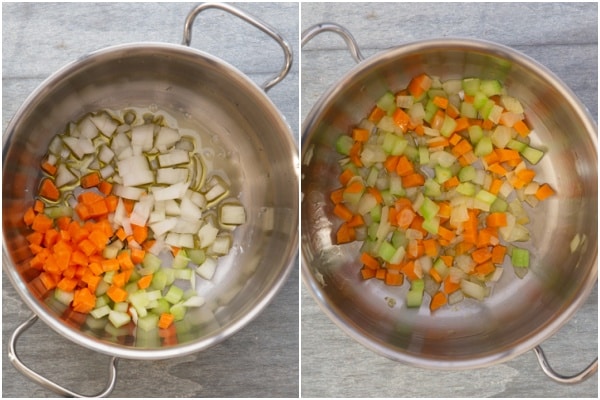
Raise the heat to medium and add the ground beef and pork, stirring and breaking up the meat as it cooks and browns. Raise the heat to high and add the red wine and cook until the wine has evaporated. The liquid should evaporate without burning the meat or veggies.
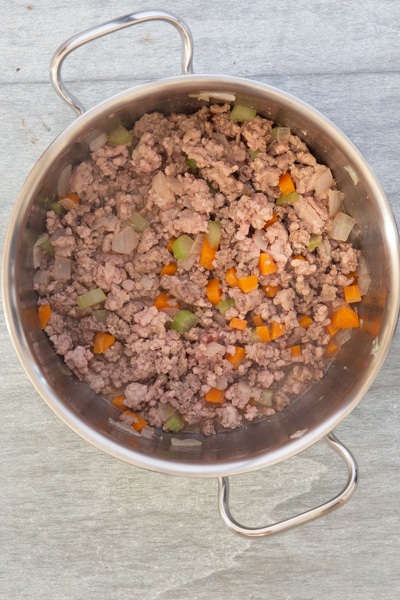
Lower the heat to medium and add the tomato paste and Tomato Puree (not stewed or pelati or fresh tomatoes), salt pepper and a whole bay leaf or two.

Bring the sauce to a boil, then gradually lower the heat to the lowest level. Cover the pot, and stir occasionally. The sauce must cook slow and low for three hours, do not boil or the sauce will burn. During the last 15-20 minutes of cooking, raise the heat a little and cook on a slow boil stirring often.

After three hours remove the bay leaf and add the milk, heat the sauce thoroughly, for a couple of minutes.
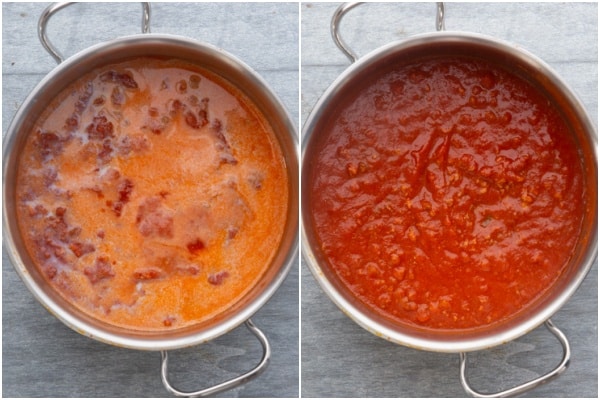
Serve over cooked pasta.
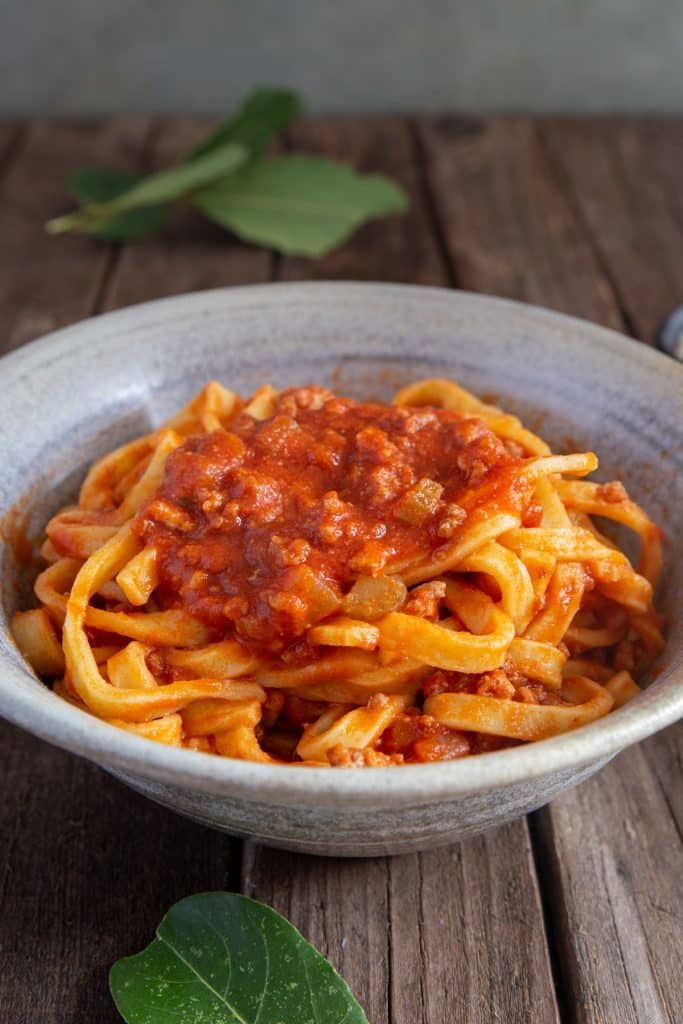
What is the difference between Meat Sauce (Ragu) and Bolognese?
The main difference, is the different cut of meat used in the preparation of the sauces. Bolognese sauce is made with ground meat, while meat ragù (Neapolitan) sauce is made with pieces of whole meat.
To cook a meat sauce (ragù), a mixture of cuts of beef and pork is generally used, opting for fatty meat that can withstand the long cooking times required for the preparation of this tasty sauce. Usually 6 hours is required whereas 2-3 hours is needed for Bolognese.
To obtain the best Bolognese sauce it is preferable to use tomato puree (passata). It is advised to never use canned peeled tomatoes and or fresh tomatoes because they release a lot of water during cooking and would therefore affect the intense flavor and its consistency.
According to Bolognese tradition, the tomato puree should be added to the meat at room temperature and not cold from the fridge. Whereas San Marzano tomatoes are used in the Naples ragù sauce along with a spoonful of tomato paste to strengthen the flavor. Although most Italians will use passata also for the sauce.
Why add milk to the Bolognese Sauce?
The milk (sometimes heavy cream is used) in the Bolognese sauce is generally added if the pasta you are serving it with is a dry pasta and is added at the end of the cooking time. But if you are using a fresh egg pasta, such as tagliatelle, adding it is optional. I always add it because I like the taste and flavor it gives the sauce.
What is the best red wine to use?
A medium-bodied red wine with a moderate tannins, like a Cabernet Sauvignon, Merlot or Pinot Noir is the best to use. A wine you would drink is always the best choice.

What is the best pasta to serve with Bolognese Sauce?
In Italy, Ragu Bolognese is traditionally served with Tagliatelle. And preferably fresh egg Tagliatelle. Although I have been served pappardelle with the sauce. And of course, always cooked to al dente. The sauce is also used to make a very popular Lasagna alla Bolognese!
What to serve for dessert?
For dessert you are going to want a simple lighter dessert. For example a creamy Panna Cotta, a lovely Strawberry Semifreddo or how about a simple No-Churn Cappuccino Ice Cream?
Tips for making the Best Bolognese Recipe
- Use an equal part of ground beef and pork, make sure it is not too lean, more on the fatty side.
- Be sure to cut (with a knife) the carrot, celery stalk and onion finely but not so much that it may become pulpy.
- Sautee your vegetables first on low heat then add the meat, which is cooked on a higher heat.
- True Bolognese is cooked on the lowest heat for at least two – three hours.
- Bolognese sauce as you can see does not contain garlic, oregano or basil.
There is no such thing as a quick Bolognese Sauce, Authentic Bolognese must be slow cooked for usually three hours, nothing rushed here. And when you try it, you’ll know it was worth every minute.
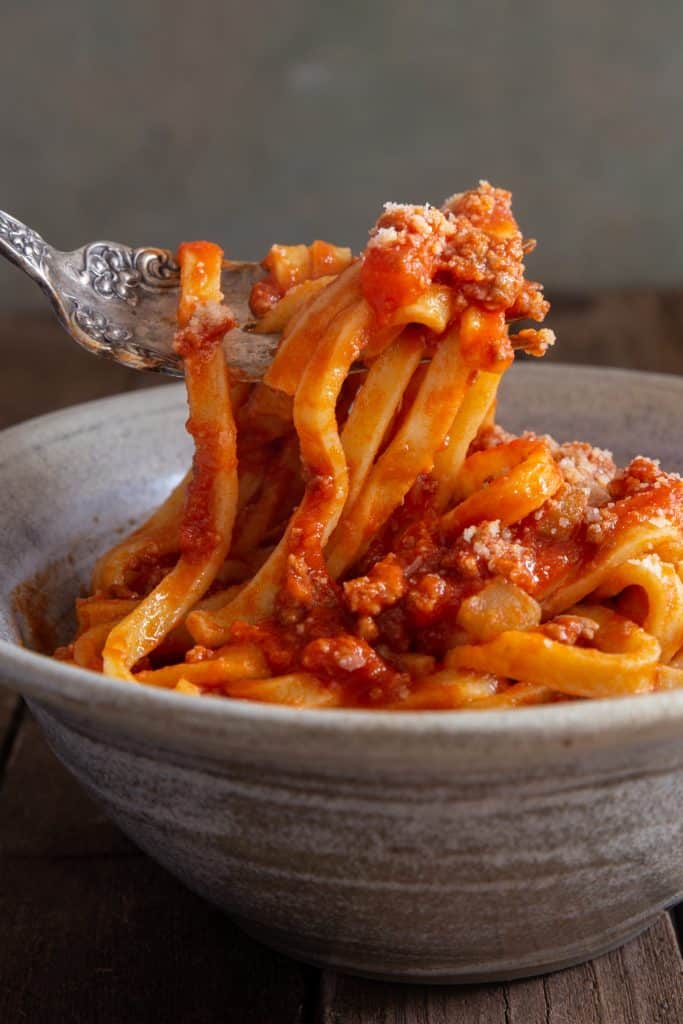
Can you use White wine?
Red wine is always considered better to use with meat dishes and white with fish dishes, but if you are out of red and only have white you could definitely use it.
How to store the Bolognese sauce
Any leftover sauce should be stored in an airtight container and kept in the refrigerator. It will keep for up to 5 days in the fridge. The completely cooled sauce can also be frozen. Place in a freezer safe container, it will keep for up to 3 months. Thaw the sauce overnight in the fridge.
I’m sure this sauce was the actual reason for the Italian saying “Fai la Scarpetta” or “Make the little shoe” which means grab a piece of bread and wipe up any left over sauce in your plate, that way you enjoy every last bite! Buon Appetito.
More delicious Italian pasta sauces to try
- Easy Tomato Cream Sauce – the perfect sauce for ravioli.
- Fresh Tomato Sauce – the best sauce for using all those delicious summer tomatoes.
- Creamy Red Pepper Sauce – one of our favorite cream sauces, a definite must try!
- Parmesan Cream Sauce – a versatile sauce that can be used even as a dip.
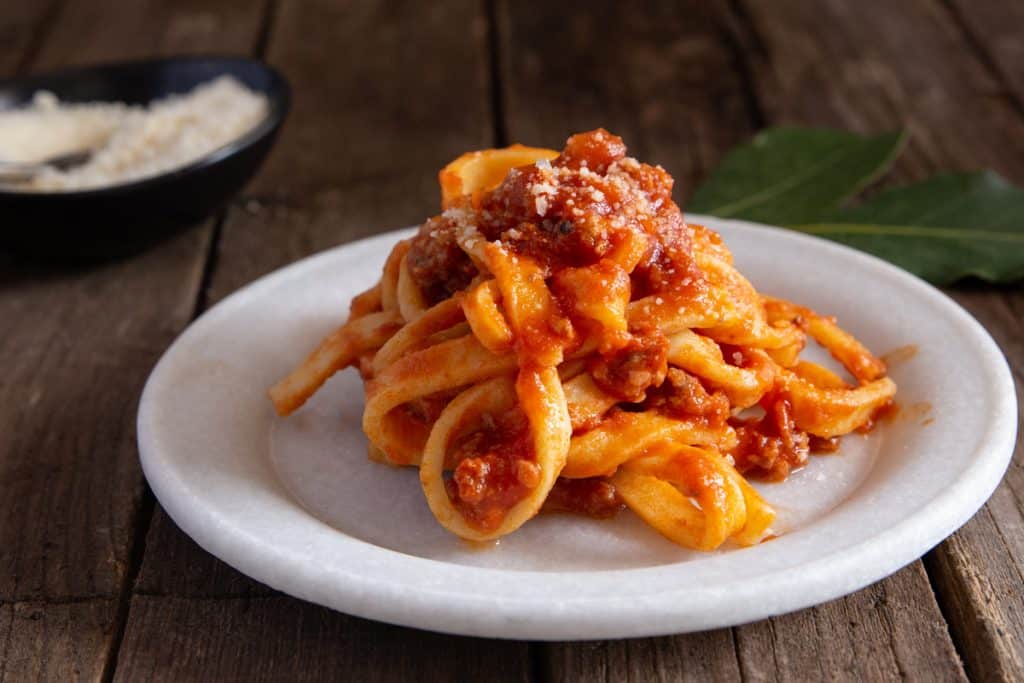
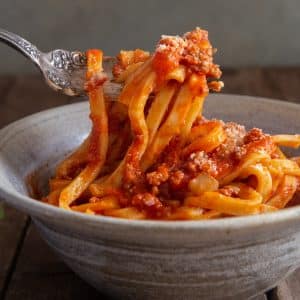
Authentic Bolognese Sauce
Ingredients
- 2 tablespoons olive oil
- 1 small/medium carrot
- 1 small celery stalk
- 1 small onion
- 10 1/2 ounces ground beef (70-80%)
- 10 1/2 ounces ground pork
- 1/2 cup dry red wine
- 2 tablespoons tomato paste
- 2 1/4 cups tomato puree (passata)
- 2-3 pinches salt
- 2 dashes pepper
- 1-2 whole bay leaves
- 1/3 cup milk (2 % or whole milk)
Instructions
- Cut the carrot, celery and onion very fine (must not too much that it becomes pulpy when cooked).
- In a medium to large heavy pot add the olive oil and chopped vegetables, cook covered on low heat (stirring occasionally) until onion is transparent.
- Increase the heat to medium and add the ground beef and pork. Stirring as the meat is cooking to break up the pieces. Once the meat has browned turned the heat up to high and add the wine.
- Cook until the alcohol has evaporated (about 20-30 seconds) and the liquid has evaporated. Decrease the heat to medium/low and add the tomato paste, puree, salt, pepper and bay leaf. Gradually decrease the heat to the lowest setting cover and let simmer for three hours (the mixture should not boil). Stir occasionally.
- After the time has passed remove the bay leaf and add the milk, heat thoroughly for a couple of minutes. Serve over cooked pasta. Enjoy!
Notes
Nutrition
Updated from September 18, 2019
Hi! Your recipe looks amazing and I’d love to make it tonight – just wondering what you think about adding pancetta? And at what point would I add it (rookie chef here lol)? Thanks!
Hi Leah, sure why not? I would add it when you add the meat, then cook it slowly all together. Let me know how it goes.
Delicious and so easy to make!
Hi Paola, thanks so much, glad you enjoyed it. Take care.
The metric conversion does not work
Hi Marianne, why doesn’t it work? Click on metric and it converts. 🙂
I thought real Bolognese did not use tomato sauce or paste
Hi Tony, I have no idea why people think that, I have never seen anyone in Italy or commercials on tv that don’t include tomato passata or even paste in it. 🙂
You are wrong Tony. Also Bolognese varies in ingredients depending on what region in Italy is from, but there is always tomato puree/sauce (passata) and some regions add paste.
So simple and so authentic. No herbs and spices. Time is no problem. Get it on early and work while it simmers. Delicious!
Hi Robin, thanks so much, so glad you enjoyed it. Have a great weekend.
Hi! I am thinking of making this for a very important dinner party – i would like to double the recipe and cook it the day before in order to save time the day of (and in hopes of the flavors melding together) is this ok? Thank you
Hi Amanda, sounds good, doubling it might take longer to cook the veggies and meat maybe 10-15 minutes longer, other than that, sounds good. And be sure to refrigerate it and yes it will definitely taste even better the day after. Let me know how it goes.
Very good recipe! Simple and very delicious, like a restaurant
Thanks so much Melissa, glad you enjoyed it. Take care.
I am allergic to tomatoes so I made this with carrot puree and added some beef bone broth. It was amazing. thank you for the recipe
Hi Debbie, thanks so much, and carrot puree sounds very interesting. Merry Christmas.
If you can tolerate red pepper, it works amazing with either jarred or fresh roasted red peppers. My best friend is allergic and I make her a special batch.
Hi, getting ready to make this recipe. Can I double/triple it and freeze the leftovers for later? Thanks.
Hi Katie, yes you can freeze the leftovers. Be sure to freeze in a freezer safe container. The sauce will last up 4-5 months in the freezer.
Thank you for a delicjous recipe. I always cooked my meat sauce over night, using stock and no wine. My sauce was intense, and i loved it. My italian colleague want impressed, and we had a beef over this. I accept defeat, since after following this, I have changed my ways.
However, I did the following changes:
I used more veggies, so I ended up with about 75% volume of equal parts of the 3 veggies, compared to the amount of meat. One medium+ carrot, one medium++ onion and 2-3 medium sized celery stalks.
I also sauteed the veggies first, moving them to a large pot, so the meat can get a good sear instead of being steamed in a crowded pan.
If I am not being authentic with these changes, thats something I can live with.
But again, thank you for a simple and delicious recipe!
Thanks Anders, glad you enjoyed the recipe. Take care.
How many people will this recipe feed. I am planning on 6-8
Hi Christine, I would say 6-8 also, maybe closer to 6.
My family love this recipe. It tastes fantastic and easy to prepare. I am not a fan of bay leaves so when I cooked it the first time I wasn’t expecting much but I was pleasantly surprised.
Hi Pauline, thanks so much, so glad everyone enjoys it and you too! Take care.
I was interested to see that you did not use any garlic in this classic recipe.
Hi Anne, no garlic in authentic Bolognese Sauce. 🙂
Tip 2: “Sautee your vegetables first on low heat then add the meat, which is cooked on a higher heat.”
Not sure I understand the logic of this. If the intent is to not burn over overcook the vegetables because they are more delicate, cooking them fist doesn’t seem to make sense if you are just going to subject them to the higher heat when the meat is added later. You are still subjecting them to higher heat, it’s just later in the process.
To me it seems more logical to cook the meat at the higher temperature first, then lower the heat and add the vegetables to gently sautee. That or cook the vegetables low heat first, remove from the pan and cook the meat at the higher temp, lower temp and then add back the vegetables.
Am I missing something here?
Hi Kristy, the meat is actually cooked on medium heat not high, because it won’t brown quick enough on low heat, you want all these ingredients to cook and mingle together, it only takes a couple of minutes and stirring the ingredients will keep the veggies from burning. You have to turn up to high in order to remove the alcohol in the wine. Trust me it works.
Would this be okay to use in a lasagna as well?
Hi Matt, sure I might add a little extra water at the end, or it will be too thick for the lasagna. Let me know how it goes.